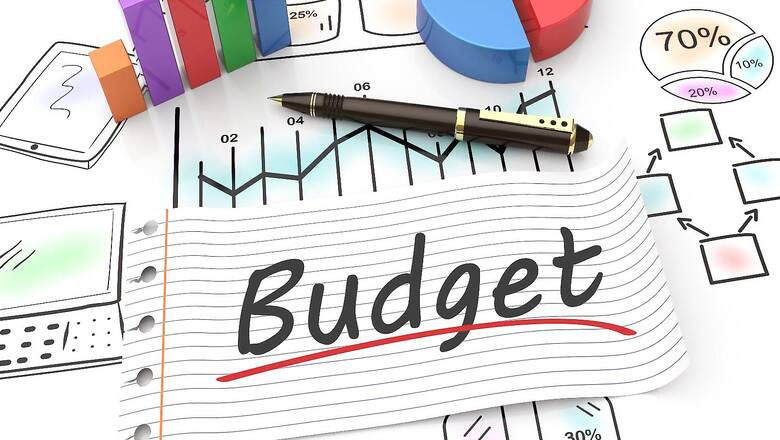
views
Ever since Finance Minister Nirmala Sitharaman presented her fifth and last full budget of the Modi government’s second term on February 1, 2023, every aspect of the budget has been analysed thread-bare by stakeholders, experts, and members of the commentariat. This author, himself, starting with the analysis of the economic survey, analysed the budget story through his framework of a five-part series.
Make no mistake- along with the finance minister’s budget speech and demands for grants, the outcome budget (OB) forms the trinity of the most important budget document and still, only a few have decided to deep dive into it. And the reasons are as follows-
- The outcome budget, in its current avatar, is of recent origin and has not yet received the proper attention of the commentariat.
- It is a complex, confusing and lengthy document that is difficult to decode. The FY24 outcome budget is 280 pages long, while FY23 one was 297 pages long.
- Unlike demands of grants which provides actuals of previous, revised estimate of current year and the budget estimate for next year, the outcome budget is a standalone document that just enumerates the budgeted output and outcome targets for selected schemes under ministries and departments. It throws no light on what was the target of the previous year, nor does it throw light on past years’ achievements against the target.
It is natural then that the outcome budget does not get the attention of the analysts it deserves. And this in itself was reason enough for this member of the commentariat to deep dive into the outcome budget of FY24 and to arrive at meaningful insight to also examine the outcome budget of FY23 critically. And here goes my analysis. As two years’ outcome budget documents are so voluminous, this analysis covers only outcome budget of two Ministries with an attempt to grasp whether the budgetary outlay for FY24 is properly aligned with monitorable outputs and outcomes or whether the outcome budget has turned into a standalone document falling short on its basic premise, losing its rigour and seriousness.
The key aspect that I seek to address is whether output, outcome and key milestones to be achieved in the financial year are synced seamlessly and explained synchronously because, in its absence, the budget outlays remain what they are— simple annual expenditure targets defeating the very purpose of having an outcome budget.
THE OUTCOME BUDGET
For the uninitiated, I begin with a primer on- what is the outcome budget.
Till recently, before FY2017-18, as part of the Union budget, only the financial outlays of schemes of various ministries were part of the budget document while the expected outputs and outcomes of schemes were prepared and presented separately by each ministry (initiated by P. Chidambaram as Finance Minister in FY2008.)
Beginning FY2018 budget, a big-ticket structural reform to the annual budget exercise was introduced in form of an Output-Outcome Monitoring Framework (OOMF) or Outcome Budget document. The outcome budget starts with the acid test question, “Do higher outlays of a ministry, department, sector, programme or scheme, necessarily mean or result in better outcomes?” While presenting the first outcome budget in FY18, the FM began with the bold pronouncement- “Citizens are interested in outcomes, not outlays.”
As such, the FY17-18 budget made a radical departure from the past with the presentation to the Parliament in all three- outlays, outputs and outcomes- in measurable terms as part of the budget.
Explaining Outlay, Output and Outcome
The Outlay is the amount provided for a given scheme or project in the budget; while the Output refers to the direct and measurable product of program activities, often expressed in physical terms or units. And the Outcomes are the collective results or qualitative improvements brought about in the delivery of these services, often expressed in terms of improvements over ex-ante or earlier indicators and benchmarks.
Presenting the outputs and outcomes along with the financial outlays as a part of the budget documents is supposed to clearly make available for analysis the defined objectives and goals for each scheme.
WHY OUTCOME BUDGET
The purpose of the introduction of the outcome budget was to radically enhance the transparency, predictability and ease of understanding of the government’s development agenda. And in the government’s own words –more precisely, it aims to nurture an open, accountable, pro-active, and purposeful style of governance, by transitioning from mere outlays to result-oriented outputs and outcomes for ministries and other stakeholders to keep a track of the scheme objectives and work towards the development goals set and ensure that the development goals set by them are achieved.
In view of the abovementioned, an outcome budget is a tool provided to stakeholders to critically understand, analyse, and comment upon them to clearly assess the government’s policies and its real development agenda.
OUTCOME BUDGET FY23-24
As enunciated in the preface of the FY23-24 OOMF or outcome budget document, it presents (a) the financial outlay for FY24 along with (b) clearly defined outputs and outcomes (c) measurable output and outcome indicators and (d) specific output and outcome targets for FY24.
The FY24 outcome budget document presents the Output-Outcome Framework for all major Central Sector (CS) Schemes and Centrally Sponsored Schemes (CSS) with an outlay of equal to and more than Rs 500 in FY23-24, thereby covering 148 CS/CSS schemes.
For paucity of space, I analyse schemes of just two ministries- Ministry of Rural Development and Ministry of Railways.
MINISTRY OF RURAL DEVELOPMENT
Outcome budget for FY24 for the Ministry of Rural Development considers 5 schemes under the department of rural development (against 8 in FY23 budget) and 1 scheme under the Department of Land Resources in both FY23 and FY24. I analyse a few schemes pertaining to the department of rural development-
First, MGNREGA – In FY23-24, the outlay for MGNREGA is Rs 60,000 crore as against Rs 73,000 crore in FY23, a substantial reduction from last year. And this reduction is despite the fact that Covid-19 has sent millions of rural households reeling into poverty. However, the past track record of the outlay of the MGNREGA scheme gives hope that this being a demand-driven program, the outlay will get increased mid-year if the need arises.
MGNREGA’s output focus is singular– (a) Providing employment, improved institutional capacity and creation of durable assets and (b) introducing new work programmes.
Against the above mentioned output, the comparable output indicators for (a) are (i) number of person-days generated in crores) (ii) total number of assets generated during the year- in numbers and (iii) percentage of people provided with employment against demand.
But here lies the big bug. The outcome budget, say output indicators ‘target not amenable.’ And it has an explanation for the same- “MGNREGA is a demand-driven programme where works are executed in Gram Panchayat level and there is no such target for execution, hence outcomes/target cannot be predicted. However, achievement made on various indicators will be reported during the course of the year on quarterly basis.”
It is a sad commentary on the state of affairs where the actual data of such a key empowerment scheme cannot be collected, collated, and commented upon and utilised. And the outcome budget of this year should have collected and collated the achievement of at least three quarters of FY23.
Moving from outlay and output to outcome, the laudable outcome of the scheme is “providing economic security and creating rural assets.” For the FY24 outcome, there are three indicators (i) micro irrigation works undertaken in hectares (ii) afforestation work in numbers and (iii ) creation/renovation of water bodies in numbers. Outcome again is a block box as no targets whatsoever are provided.
Another important aspect of MGNREGA scheme for FY24 is that it has reduced the number of outcome indicators from 6 in FY23 to 3 in FY24 without explanation, duly removing (i) participation of women- in percentage, (ii) participation of SC – in percentage and (iii) participation of ST – in percentage, as if this analysis has become redundant.
Any dropping of indicators without explanation is fraught.
Second, Pradhan Mantri Awas Yojana-Gramin (PMAY-G) – This is one scheme where the outlay has jumped from Rs 20,000 crores in FY23 to much needed Rs 54,487 crores in FY24. This is indeed a big jump in the outlay. The scheme focuses on the measurable output of the “construction of pucca houses with adequate basic services.” This indeed is the need of the hour. Output indicators with targets are well defined (i) number of houses completed in lakhs (57.33) (ii) number of masons trained 50000 (iii) number of SC & ST beneficiaries in lakhs (30) and (iv) percentage of houses owned by women & men beneficiaries (65 percent).
Given the severe crunch of affordable pucca houses in villages, this is one of the true flagship programs of scale of the government.
The scheme has a clearly defined outcome “more HHs live in dignified homes with access to basic services.” Outcome indicators and targets too are measurable- (i) change in houselessness (85 percent), (ii) change in forced migration due to houselessness (15 percent) and (iii) satisfaction level of beneficiaries of the schemes reported in FY24 (99 percent).
I have only one discordant note-In FY22-23, the scheme had six measurable output indicators and targets. In the current year budget, the same stand reduced with the axe falling on – (i) number of landless beneficiaries to be provided land- one lakh and (ii) number of houses sanctioned- 50 lakh. I am foxed by the deletion of these categories unless the government is sure that all the needy who need affordable houses under the scheme have been sanctioned and no new sanction is needed, and the rural area does not have any more landless family that needs a home under the scheme.
Having covered the advent of PMAY and witnessing its progress on ground, I posit it is the scheme whose time arrived much earlier and is making a dent in homelessness but still, I find it a humungous task to measure the outcome in terms of defined outcome indicators and targets.
Nonetheless, the scheme scores rather high on my assessment.
Third, Pradhan Mantri Gram Sadak Yojana (PMGSY)- The outlay under the scheme for the FY24 at Rs 19000 crore is unchanged from the outlay of FY23.
The outcome budget eloquently talks of the ‘availability of quality all-weather road and its timely maintenance’ with the six output indicators with targets – (i) road length added- 38000 km (ii) work inspected by NQM in numbers-8 (iii) completed works rated unsatisfactory (5 of inspected works by NQM, average of last 3 years) (iv) maintenance works rated unsatisfactory (5 of inspected works by NQM, average of last three years less than 15) (v) proportion of complaints related to PMGSY older than 1 month addressed on MeriSadak App-100 percent and (vi) road length constructed using green technology -18000 km.
I find the outcome target for FY24 aspirational. “All-weather road connectivity of eligible habitations is also pathways for access to education, health, market and mobility” aspirational but this is what the need is. The outcome indicators and targets for one year at 100 percent of the five eligible habitations are more grounded in reality.
This is what it must be.
But here are two discordant notes-
Firstly, compared to FY23, the following output indicators and targets are missing from the FY24 outcome budget without explanation- (i) sanctions under PMGSY-III-in km- 25000 km (ii) road length upgraded under PMGSY III-in km-35000 km (iii) road safety audit done for PMGSY-III roads- as number of roads-1100 numbers.
Such vanishing acts without explanation make the task of analyser difficult.
Secondly, I find it difficult to accept that a system, a statistical system, that is unable to effectively measure the progress of flagship scheme MGNREGA is indeed effectively measuring the output and outcome targets of the PM Sadak Yojana, more so because the past performance is not documented for comparison and analysis.
Fourth, Deendayal Antyodaya Yojana-National Rural Livelihoods Mission (DAY-NRLM) is another scheme with Rs 14,129.17 crore outlay in FY24 against Rs 13,336.42 crore in FY23.
The scheme has laudable outputs like social mobilisation of poor households and institution building, sustainable livelihood services to the poor, SHG members operating small businesses, skill training & placement and financial inclusion of Self Help Group (SHGs). It also has a measurable target. Moving from output to outcome, again the outcome is sanguine – Sustainable livelihoods of the poor through skill building, access to credit, marketing and other livelihood services and financial inclusion of SHGs.
But in the absence of actual performance of the scheme in previous years, I am unable to analyse the same.
MINISTRY OF RAILWAYS
The Railways Ministry this year has received the highest-ever allocation from the budget- Rs 2,40,000 crore and its current year capital outlay is at an all-time high at Rs 2.60,000 crore. Here, I attempt to analyse the Indian Railways FY23-24 outcome budget duly comparing the same with that of FY22-23. Below is the analysis of selected railway schemes-
One, construction of new lines, gauge conversion and line doubling- The combined outlay in FY24 for the three schemes is Rs 67,199.4 crore with the trifurcation-new lines (Rs 31,850 crore); gauge conversion (Rs 4,600 crore) and line doubling (Rs 30,749.4 crore). This outlay is significantly higher than Rs 40,201.08 crore combined outlay in FY23 with trifurcation being-new lines (Rs 25,243 crore); gauge conversion (Rs 2,850 crore); line doubling (Rs 12,108.08 crore).
This is something to cheer at.
Beyond the outlay, the measurable output is– ‘the greater speed of construction of new lines, gauge conversion and line doubling.’ The output indicators for FY24 of completion of 600 km new line and 2800 km line doubling in FY24 is way above the completion of 300 km newline and 1700 km line doubling target in FY24. The gauge conversion reduced target from 500 km in FY23 to 150 km in FY24 reflects not much is left for conversion from MG and NG to BG.
This shows Indian Railways (IR), after decades of stagnancy, is finally chugging along the right path. For long, the IR’ claim to fame has been the completion of 766 km of Konkan Rail in hostile terrain in record seven years. It is time to break the mould.
Nonetheless, I posit that the IR construction record has been poor and expediting the same is still a work in progress. I posit it because- firstly, the outcome budget does not indicate to what extent the output target of previous year was met; secondly, the output target remains incremental and not aspirational and thirdly, for India to reduce its logistics cost using sustainable transport mode, the outlay and consequent output and outcome target is not enough.
Moving beyond the output, the outcome parameter is not robust- ‘adding 14 new locations in FY24 with greater access to unconnected areas (against 19 in FY23)’ does not talk of the extent of the country’s area on the rail map, nor does it give a clue of how many locations have been brought to the rail map in recent years.
For line doubling the outcome is ‘greater safety and throughput as well as more freight services on congested routes’ with outcome indicators being – 14 percent increase in passenger throughput and a 5.4 percent increase in freight throughput in FY24 against last year. Yet, there is no clue available as to the ground realities and the gap yet to be bridged against. One does not get a true and fair picture of the IR which is consistently losing freight to roads and passengers to buses and air.
Whither Indian Railways?
At the time of independence, the rail route km in India was 54983 km (25170 BG, 24153 MG and 5370 NG). It carried over 80 percent freight and 90 percent passengers. Since independence, the IR has barely added 14000 km route length at the rate of 167 km per year.
In 2020, the IR route length increased to 67,995 km (63949 km BG, 2402 km MG and 1809 km NG) which carries less than 25 percent of national freight throughput and 10 percent of passenger throughput.
It puts the IR in a terminal existential crisis. And if it has to achieve the target of carrying 45 percent of freight throughput of the nation by 2030, it requires nothing less than a complete transformation in the way IR conducts its business.
If we step back and look at China, which India will dethrone this year as the most populous country, in 2022, operationalised a 3300 km new line and will add another 3000 km in 2023. China was way behind India in 1950 but has galloped to 150000 km rail route length in 2022 against India’s 67000 km and it will have 200000 km rail line by 2035 and during the same period, China will also double the length of high-speed line (already world’s longest) from current 42000 km.
If India has fast-pruned its logistics cost drastically to turn a developed country by 2047- it has to metamorphize its rail network.
Two, as regards fixed infrastructure overhauling, the track renewal and strengthening assumes greater salience- while the FY24 outlay of Rs 17,296.84 crore for track renewal is above Rs 13,335.47 crore of FY23, I posit it is not commensurate with the actual need. Firstly, the outcome budget does not talk about the current arrear of the quantum of track renewal. Secondly, it is silent about track upgradation to meet the speed of 160 kmph requirement, at least on trunk routes or on the path where Bande Bharat trains are operating or soon will operate.
The output target for track renewal- ‘Greater length of tracks renewed is notable’-at 4800 km in FY24 against 3700 km in FY23. But one does not know how much of the past year’s 3700km target was actually met as the outcome budget is silent on the actual performance. Also, the desired outcome and outcome indicators against the track renewal are absent. At least the FY23 budget mentioned an opaque “reduced pipeline of track renewal works” without mentioning from how much to how much, though it mentioned it was completing all the sanctioned works in 2-3 years. What about track renewal work not yet sanctioned? Has the IR completed the entire track renewal exercise it needed? There are no answers. An outcome budget that is non-transparent indeed needs further reform.
Clearly, a lot is needed to take the task of track renewal and track strengthening to the desired level and outcome budget needs to be quantified properly.
Three, ‘rolling stock is the most critical moving asset’ needed to fast-track freight and passenger throughput. The FY24 rolling stock budget of Rs 37,581 crore is praiseworthy 4.5 times that of the FY23 outlay of Rs 7977.84 crore.
Output outcome target for rolling stock
The FY24 outcome budget measures the output in terms of “acquisition of rolling stock of each type” with the output indicators – number of electric locomotives operationalized (1190), number of LHB coaches operationalized (6978) and number of track machines operationalized (150). This is against 685 electric locomotives, 5489 LHB coaches and 150 track machines respectively in FY23.
From the output budget, I am unable to get a hang of the much talked out program of operationalizing 300 Vande Metro trains, 1,000 eight-coach Vande Bharat trains, and 35 hydrogen trains repeated by the IR.
Coming to the outcome framework for rolling stock for FY24, the IR aims to achieve “greater throughput in freight and passenger services” – 10 percent in passenger throughput and a 4.8 percent increase in freight throughput, both over the previous year. The comparable target of outcome for FY23 was an 88 percent increase in passenger throughput (PKM) from the lower base due to Covid and a 5.4 percent increase in freight output (NTKM).
But the problem with the current OOMF is, it does not indicate what part of the last financial year’s budgeted output-outcome was actually achieved or how much of existing old ICF coaches are in urgent need of replacement by LHB coaches. Worse, it gives no clue to the desired level of all types of rolling stock augmentation to ensure railways pie in the consistent 7-8 percent GDP growth and the freight movement by the IR. It does not give a clue how the IR will achieve 45 percent freight throughput of the nation. It needs a hard purposive action on the ground as there is no magic wand.
The above clearly shows the need for more fundamental reform to the output-outcome budget as the present framework remains patchy and incomplete.
Four, the customer amenities– FY24 budget provides an outlay of Rs 13,355 crore towards passenger amenities for the IR. It is where the consumer intersects with the IR system. This allocation is five times (Rs 2,700 crore) of FY23 and looks exceedingly good at the face value.
But I deep dive into the output outcome budget under the head passenger amenities and the picture that emerges is not that rosy. The measurable output- ‘building better passenger amenities’ is laudable. But it does not tell how much the gap is. The IR has to reach from where to where. More so because passenger amenities are not rocket science.
The outcome budget talks of two types of passenger amenities- one, the number of stations upgraded. The target for the same was 30 stations in FY23 and the FY24 output target is 50 stations. The outcome against this measurable output is rather vague – “greater passenger satisfaction-passenger satisfaction index of 85 percent both in FY23 and FY24.”
As someone who has been anxiously following the conundrum of railway station development for the last 18 years, I can only pray that at least 10 of the proposed 50 stations are upgraded in the financial year. Such has been the travesty of the station modernization program of Indian Railways. To me, that itself will be a big achievement.
The second item passenger amenities are the construction of 150-foot over bridges both in FY24 and FY23. The output budget does not provide any clue of how many foot-over bridges are needed on railway stations across the country, how many were sanctioned in the current tenure of the government and how many of them were completed.
Yours truly is truly happy that at least for once, the IR in terms of the capital outlay and modernization is getting its due, but for the last 75 years, its neglect has been so total that country needs a truly transformative agenda to bring back railway to its past glory.
The author is a Multidisciplinary Thought Leader and India-based International Impact Consultant. Making tomorrow’s infrastructure happen today is his passion. He works as President Advisory Service of consulting company BARSYL. Views are personal.
Read all the Latest Opinions here



















Comments
0 comment